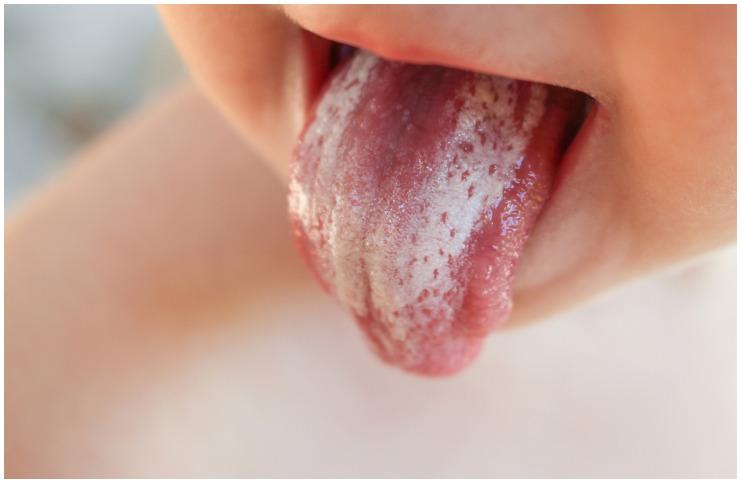Newborn Thrush vs Milk Tongue – Symptoms, Causes, Differences:
Newborn Thrush
Thrush is an infection that is caused by a yeast germ called Candida albicans. The mouth is a common site where C. albicans causes infection.
This yeast thrives in moist, dark places and is the same yeast that causes a vaginal yeast infection for women.
It is thought that about 90 percent of babies will have an overgrowth of Candida on and/or in their bodies by the time they are 6 months old.
Also, older babies can develop this condition if they have a depressed immune system, have been formula-fed, or have been taking antibiotics to fight another infection.
C. albicans is supposed to be there, and it is typically kept under control by the other beneficial bacteria in the body. But, occasionally, certain medications (especially antibiotics) or illnesses can disturb the bacterial balance and can lead to an overgrowth of Candida.
Newborn babies have an increased risk of oral thrush due to the fact that their immune system is not developed completely, therefore, the resistance to fight any type of infection is low.
In addition, newborns with mothers who have a history of frequent vaginal yeast infections are more vulnerable to this problem.
Symptoms
Common signs and symptoms may include:
- poor weight gain;
- a whitish sheen to their saliva;
- nappy rash;
- clicking sounds during feeding;
- refusing the breast or constant detaching from the breast.
If a baby has this condition, his mother (if she breastfeeds) most likely has it on her nipples and breast.
Symptoms include:
- a burning sensation in the breast;
- nipples which are red or pink;
- itchy nipples, that may be extremely sensitive to touch;
- nipples which become sore after a period of pain-free breastfeeding;
- cracked nipples that don’t heal.
Causes
Thrush usually happens when the baby or mother has taken antibiotics.
Antibiotics treat infections from pathogenic bacteria, however, they can also kill the beneficial bacteria, and this leads to an overgrowth of yeast.
In addition, it may occur in babies since their immune systems have not yet matured and they are less able to resist infection.
Breastfeeding mothers are at increased risk to get this condition because the infection can pass from the mouth of the baby to her breast. If a breastfeeding mother has thrush on her nipples and breast, she will feel a painful sensation while her baby is feeding.
Note – according to a 2009 research, Candida is prevalent in pacifiers, particularly latex pacifiers.
Treatment
Oral thrush in newborns is not a serious medical condition and can be cleared with a treatment that is in the form of a gel, like – miconazole.
This antifungal medication should be applied to the affected areas but avoid the back of the mouth.
Sometimes, newborns who are treated with this antifungal are sick after it is applied, however, this typically passes as they get used to it.
It is recommended to give the baby this oral medicine just after he has been fed. Once the infection has cleared up, you should continue to use miconazole for another two days.
If the condition hasn’t gone completely after a week of continuous treatment, contact your healthcare professional again.
Gentian Violet
Gentian violet, also known as crystal violet, is a triphenylmethane dye with anti-tumor, anti-angiogenic, anti-trypanosomal, anti-helminthic, anti-fungal, and anti-bacterial properties.
It is commonly used for:
- treating impetigo (a bacterial infection that involves the superficial skin);
- treating Candida albicans and related fungal infections
- marking the skin for surgery preparation.
Some specialists recommend applying gentian violet (not for internal use) to the baby’s mouth.
According to studies, gentian violet is effective in clearing an overgrowth of fungus, having a 75 percent cure of the illness in about 11 days of use.
If your baby has this condition in their nappy area and mouth, you will need to treat both areas at the same time. For a yeast diaper rash, it is recommended to use nystatin. This drug is on the WHO’s List of Essential Medicines.
More importantly, due to the possible severity of yeast infections in the breasts, it is strongly recommended that the mother’s nipples be treated along with the baby’s treatment.
The amount of medicine which you take depends on the strength of the medicine.
Note – infants aged under 4 months with signs of oral thrush should see a general practitioner for treatment advice.
Prevention
The prevention of thrush is concentrated on maintaining the baby’s hygiene and health, especially oral health. Additionally, the tongue should be cleaned on a regular basis to ensure the risk of infections caused by bacteria, fungus, or germs is reduced.
Note – before cleaning the tongue of a baby, make sure your hands are clean.
To reduce the risk of infection in your baby’s diaper area, change diapers regularly and keep the skin as dry and clean as possible.
Milk Tongue
One of the main reasons for the white tongue among newborns is a thin layer of residual milk after feeding. This coating can be thicker if the baby is formula-fed.
The residual milk builds up because newborns don’t produce sufficient saliva in the first months after they are born.
However, after about three months, they produce more saliva, which will tend to wash the milk residue off.
Newborn Thrush vs Milk Tongue – Differences
If you notice a white coating on your newborn’s tongue, touch a patch with a clean finger. If this patch easily rubs away, it is most likely just milk residue because thrush won’t come off easily, plus, it has a red area underneath the white coating.
In addition, in the case of a milk tongue, the baby doesn’t have a diaper rash, and the mother’s nipples aren’t burning.
READ THIS NEXT:
Oral Gonorrhea vs Strep Throat
References https://www.ncbi.nlm.nih.gov/pmc/articles/PMC3986202/ https://www.ncbi.nlm.nih.gov/pmc/articles/PMC3048637/ https://www.evidence.nhs.uk/search?q=
